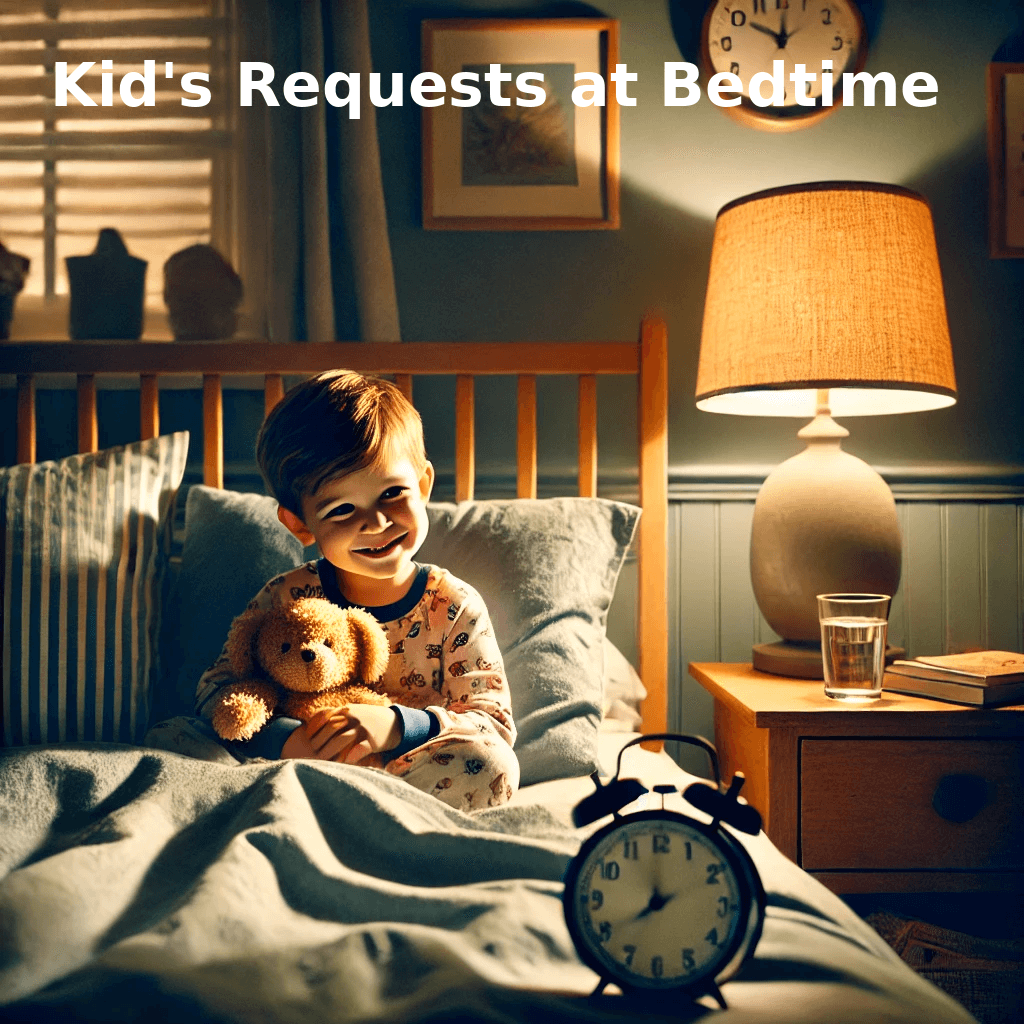Managing Kid’s Requests at Bedtime: 2025 Edition

Are you looking on ways of managing kid’s request at bedtime? Well, you are at right place.
Bedtime can often be one of the most challenging parts of the day for both parents and children. Just when you think your child is tucked in and ready to drift off to sleep, they come up with another request: a glass of water, one more story, an extra hug, or a trip to the bathroom. These kid’s requests at bedtime can prolong the routine and test a parent’s patience. Understanding why children make these requests and how to manage them effectively is essential for establishing a peaceful and consistent nighttime routine.
Understanding Why Kids Make Bedtime Requests
Children often make multiple requests at bedtime for various developmental and emotional reasons. Recognizing these reasons can help you address them more effectively.
Seeking Comfort and Security
- Fear of the Dark or Nighttime Anxieties: Many children experience fears related to the dark, monsters under the bed, or being alone. These fears can trigger requests for extra comfort.
- Separation Anxiety: Bedtime signifies separation from parents, which can cause anxiety, especially in younger children.
- Need for Reassurance: Extra hugs and cuddles are ways for children to feel safe and secure before falling asleep.
Delaying Sleep
- Not Feeling Tired: Children may not be ready to sleep due to irregular sleep schedules or daytime naps.
- Desire to Stay Awake: They might feel they’re missing out on fun activities happening after they go to bed.
- Testing Boundaries: Bedtime requests can be a way to assert independence or test limits set by parents.
Seeking Attention and Connection
- Quality Time: Bedtime may be the only time they have your undivided attention.
- Unresolved Daytime Issues: Lingering concerns or emotions from the day may surface at bedtime.
- Routine Reinforcement: Children thrive on routines, and bedtime rituals can be comforting.
Understanding the underlying reasons for your kid’s requests at bedtime can help you tailor your approach to meet their needs while maintaining boundaries.
Establishing a Consistent Bedtime Routine
Creating a predictable and calming bedtime routine is crucial for signaling to your child that it’s time to wind down. Consistency helps regulate their internal clock and reduces resistance to bedtime.
Set a Regular Schedule
- Consistent Bedtime and Wake Time: Aim for the same bedtime and wake-up time every day, including weekends. This regularity helps set your child’s circadian rhythm.
- Age-Appropriate Sleep: Ensure your child is getting the recommended amount of sleep for their age group. For example, toddlers typically need 11-14 hours, while school-aged children require 9-12 hours.
- Gradual Wind-Down: Start the bedtime routine 30 minutes to an hour before sleep time to help them transition smoothly from daytime activities.
Include Calming Activities
- Bath Time: A warm bath can relax muscles and soothe the body. Adding lavender-scented bubbles or bath oils can enhance relaxation.
- Reading Together: Sharing a story promotes bonding and literacy skills. Choose calming stories rather than those that are exciting or scary.
- Quiet Play: Puzzles, coloring, or playing with soft toys can help them relax without overstimulating them.
- Gentle Music or Lullabies: Soft music can create a peaceful atmosphere and become a signal that it’s time to sleep.
Create a Sleep-Conducive Environment
- Comfortable Bedding: Ensure the mattress and pillows are comfortable and appropriate for your child’s size and sleep preferences.
- Room Temperature: Keep the bedroom cool, ideally between 60-67°F (15-19°C), to promote better sleep.
- Dim Lighting: Use blackout curtains to block external light and consider a dim nightlight if your child is afraid of the dark.
- Noise Reduction: Minimize loud sounds; consider white noise machines or fans to drown out disruptive noises.
Limit Stimulating Activities
- Screen Time: Avoid electronic devices at least an hour before bedtime, as blue light can interfere with melatonin production, the hormone responsible for sleep.
- Sugary Foods and Drinks: Limit sugar and caffeine intake in the evening, including chocolate and soda.
- Exciting Games or TV Shows: Avoid activities that can increase adrenaline or excitement levels, making it harder for your child to settle down.
A consistent routine not only prepares your child for sleep but also reduces the likelihood of unexpected requests.
Addressing Common Bedtime Requests
Children often use specific requests to delay bedtime. Here are practical ways to handle these frequent kid’s requests at bedtime.
The “One More Story” Request
- Set Clear Limits: Decide on the number of stories or pages beforehand and communicate this to your child. For example, “Tonight we’ll read two books, and then it’s time for sleep.”
- Use a Timer: Set a timer to signal the end of reading time. This external cue can help enforce limits without you being the “bad guy.”
- Offer Choices: Let them choose which stories to read within the set limit to give them a sense of control.
- Create a Reading Log: Keep track of stories read to provide a visual cue of progress and to revisit favorites without repetition every night.
The “I’m Thirsty” Request
- Preemptive Hydration: Offer a drink during the bedtime routine to eliminate thirst as a genuine concern.
- Keep Water Accessible: Place a small water bottle or sippy cup by their bedside so they can help themselves if needed.
- Discuss Limits: Explain that drinks are provided before bed and that extra requests will not be accommodated unless necessary to prevent overconsumption and nighttime accidents.
The “I Need to Use the Bathroom” Request
- Routine Bathroom Breaks: Include a final trip to the bathroom as part of the bedtime routine.
- Assess Genuine Needs: Understand that younger children or those in toilet training may have legitimate needs. Be patient but firm if you suspect stalling.
- Limit Fluid Intake: Reduce the amount of liquid they consume in the hour before bedtime to minimize the need for bathroom trips.
The “I’m Not Tired” Request
- Physical Activity: Ensure your child gets enough physical activity during the day to promote natural tiredness.
- Quiet Time Before Bed: Engage in calming activities to help them wind down, such as reading or listening to soft music.
- Earlier Bedtime: Paradoxically, over-tired children can become hyperactive; adjust bedtime if necessary to find the sweet spot.
The “I’m Scared” Request
- Acknowledge Feelings: Validate their fears without reinforcing them. Say something like, “I understand you’re feeling scared.”
- Nightlights and Comfort Objects: Provide a nightlight or favorite stuffed animal for reassurance.
- Monster Checks: Perform a quick, playful “monster check” to alleviate fears, but avoid making it a lengthy process.
The “I Need You” Request
- Quality Time During the Day: Spend dedicated time with your child to meet their emotional needs, reducing the likelihood of them seeking attention at bedtime.
- Affirmations: Offer positive affirmations and reassure them of your presence and love.
- Stay Calm: If they call out, respond briefly and calmly, reinforcing that it’s time to sleep.
By anticipating these requests and incorporating solutions into the bedtime routine, you can reduce delays and frustrations.
Communicating Expectations Clearly
Effective communication is key to minimizing bedtime disruptions. Setting clear expectations helps your child understand the boundaries and the importance of following the routine.
Discuss the Plan
- Family Meeting: Talk about the bedtime routine during the day when everyone is relaxed. Explain why each step is important.
- Explain the Benefits: Help them understand how sleep helps them grow, learn, and have energy for fun activities.
- Visual Schedules: Create a bedtime chart with pictures outlining each step of the routine. This is especially helpful for younger children who can’t read yet.
Use Positive Reinforcement
- Praise Good Behavior: Acknowledge when they follow the routine without extra requests. Say things like, “I’m so proud of how you got ready for bed tonight!”
- Reward Systems: Implement a sticker chart or small rewards for consistent adherence over time.
- Encouraging Words: Use affirming language to boost their confidence in sticking to the routine, such as “I know you can do this.”
Be Consistent
- Follow Through: Stick to the established rules, even when it’s challenging or you’re tired.
- Unified Approach: Ensure all caregivers are on the same page regarding bedtime expectations to avoid confusion.
- Avoid Mixed Signals: Don’t give in to extra requests on some nights but not others, as this can encourage persistent asking.
Consistency reinforces the routine and helps your child understand that bedtime rules are firm.
Expert Tips for a Peaceful Bedtime
Child development experts offer several strategies to make bedtime smoother and address kid’s requests effectively.
Create a Soothing Environment
- Sensory Considerations: Use calming scents like lavender in the bedroom through diffusers or sprays.
- Comfortable Sleepwear: Ensure pajamas are comfortable and appropriate for the room temperature to prevent overheating or getting too cold.
- Bedtime Rituals: Incorporate rituals like gentle back rubs or singing a lullaby to signal it’s time to sleep.
Address Fears and Anxieties
- Open Dialogue: Encourage your child to talk about their fears during the day, making them feel heard and supported.
- Empowerment Strategies: Teach coping skills, such as deep breathing or visualizing a happy place, to manage anxiety.
- Professional Support: If fears persist, consider consulting a child therapist for strategies tailored to your child’s needs.
Stay Calm and Patient
- Model Behavior: Your calm demeanor can influence your child’s ability to relax. Children often mirror their parents’ emotions.
- Avoid Power Struggles: Keep interactions positive and avoid confrontations that can escalate the situation.
- Practice Patience: Understand that establishing routines takes time and persistence. Celebrate small victories along the way.
Encourage Independence
- Self-Soothing Techniques: Teach your child how to comfort themselves, such as hugging a stuffed animal or using a special blanket.
- Bedtime Responsibility: Involve them in preparing for bed, like choosing pajamas or setting out clothes for the next day, to give them a sense of ownership.
Implementing these expert-backed tips can significantly reduce kid’s requests at bedtime and promote healthier sleep habits.
When to Seek Professional Help
While most bedtime challenges can be managed with patience and consistency, there are times when professional assistance may be necessary.
Sleep Disorders
- Signs to Watch For: Snoring, frequent night wakings, or difficulty breathing during sleep may indicate sleep apnea or other disorders.
- Consult a Pediatrician: Discuss any concerns to rule out medical conditions that may be affecting your child’s sleep quality.
Emotional and Behavioral Concerns
- Persistent Anxiety: If fears and anxieties interfere significantly with sleep and daily functioning.
- Behavioral Issues: Extreme resistance to bedtime or other defiant behaviors may indicate underlying issues such as ADHD or anxiety disorders.
- Professional Evaluation: A child psychologist or counselor can provide assessment and support tailored to your child’s needs.
Developmental Considerations
- Special Needs: Children with developmental disorders may require tailored strategies and professional guidance.
- Medication Side Effects: Some medications can affect sleep; consult with your doctor if applicable to adjust dosages or timing.
Seeking expert advice ensures that any serious issues are addressed promptly and appropriately.
Additional Strategies for Parents
Beyond the immediate bedtime routine, there are broader strategies parents can employ to promote better sleep habits.
Promote Healthy Sleep Hygiene
- Regular Exercise: Encourage physical activity during the day to promote natural tiredness, but avoid vigorous activity close to bedtime.
- Balanced Diet: Provide nutritious meals and avoid heavy meals close to bedtime, which can cause discomfort.
- Avoid Caffeine: Limit intake of caffeine-containing foods and drinks like chocolate and soda, especially in the afternoon and evening.
Educate About Sleep
- Teach About the Body: Explain how sleep helps the body grow, repair, and prepare for the next day.
- Use Educational Resources: Books or videos about sleep can make learning fun and engaging, reinforcing the importance of good sleep habits.
Manage Your Own Stress
- Self-Care: Ensure you’re taking care of your own needs to remain patient and calm during bedtime routines.
- Support Networks: Seek advice and support from other parents, family members, or parenting groups if needed.
By adopting a holistic approach, you can create a supportive environment that encourages healthy sleep patterns for your child.
Conclusion
Managing kid’s requests at bedtime involves a combination of understanding, preparation, and consistent application of strategies. By recognizing the reasons behind their requests, establishing a calming and predictable bedtime routine, and communicating expectations clearly, parents can create a peaceful bedtime environment. Incorporating expert tips and being attentive to your child’s needs will not only reduce bedtime struggles but also foster a sense of security and well-being in your child.
Related
How to Keep Your Baby from Chewing on the Crib
How To Make a Baby Sleep Under 40 Seconds
How To Make a Baby Sleep in Bassinet






